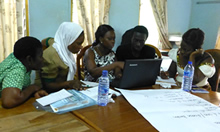Webinar attendees will be introduced to SPRING’s two new anemia-related tools that provide guidance to decision makers at the national and district level in assessing, analyzing, and acting on anemia-related data. Attendees will also hear from countries that have used the tools in their work.
Data-driven decision-making in anemia involves inputs from various sectors and stakeholder groups in nutrition, disease control, health, water and sanitation, education, agriculture, gender and social welfare, and statistics. These groups tend to operate in their sectoral silos, with few opportunities to integrate information and data sources from other sectors to advise their policy and program decisions. This holds true at the national and also at the district level.
With the objective to promote a multi-sectoral, integrated data-driven perspective to decision-making, SPRING has developed two new anemia-related tools. The Landscape Analysis Guidance provides detailed information to national policy makers and program implementers on how to gather, understand, and use anemia-related data. The District Assessment Tool for Anemia (DATA) assists program managers at the district level to use their own data effectively to prioritize anemia-related interventions.
Alexis D’Agostino, SPRING M&E Specialist, presented the Landscape Analysis Guidance, and Denish Moorthy, SPRING Technical Advisor, presented the DATA Tool. In addition to an introduction of the tools, participants heard from a panel from West Africa and South Asia on their country experiences with the tools.
